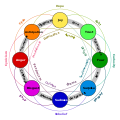| Part of a series on |
| Emotions |
|---|
  |
Evolutionary explanations for the existence of discrete emotions such as fear and joy are one of many[1] theoretical approaches to understanding the ontological nature of emotions. Historically, evolutionary theoretical approaches to emotions, including basic emotion theory,[2] have postulated that certain so-called basic emotions (usually fear, joy, anger, disgust, and sadness) have evolved over human phylogeny to serve specific functions (for example, fear alerts a human mind of imminent danger). So-called basic emotions are often linked causally to subcortical structures of the brain,[3] including the amygdala (pronounced uh-MIG-duh-luh). In other words, subcortical structures have historically been considered the causes of emotions, while neocortical (neo- meaning new, recent and cortical meaning relating to cortex) structures, especially the prefrontal cortex, are almost invariably understood as the cause of reason. Those ideas about the brain are old; they're traceable at least to Aristotle[4][5][6] and were later incorporated into Paul MacLean's mistaken model[7] of brain organization, the "triune brain."[8] These ideas have led to the widespread, erroneous belief[7][8][9] that animal brains, including human brains, evolve in a linear fashion, such that, along the course of evolution, new layers of brain tissue are stacked upon older layers of brain tissue, much like the formation of sedimentary rocks. Brain evolution is a lot more complicated than that.[3][6][10][11][12][13][14][15][16][17]
Evolution and natural selection has been applied to the study of human communication, mainly by Charles Darwin in his 1872 work, The Expression of the Emotions in Man and Animals.[18] Darwin researched the expression of emotions in an effort to support his materialist theory of unguided evolution. He proposed that much like other traits found in animals, emotions apparently also evolved and were adapted over time.[19] His work looked at not only facial expressions in animals and specifically humans, but attempted to point out parallels between behaviors in humans and other animals.
Evolutionary psychologists consider human emotions to be best adapted to the life our ancestors led in nomadic foraging bands.
- ^ Panksepp, Jaak; Lane, Richard D.; Solms, Mark; Smith, Ryan (May 2017). "Reconciling cognitive and affective neuroscience perspectives on the brain basis of emotional experience". Neuroscience & Biobehavioral Reviews. 76: 187–215. doi:10.1016/j.neubiorev.2016.09.010.
- ^ Ekman, Paul (1992-05-01). "An argument for basic emotions". Cognition and Emotion. 6 (3–4): 169–200. doi:10.1080/02699939208411068. ISSN 0269-9931.
- ^ a b Headley, Drew B.; Kanta, Vasiliki; Kyriazi, Pinelopi; Paré, Denis (July 2019). "Embracing Complexity in Defensive Networks". Neuron. 103 (2): 189–201. doi:10.1016/j.neuron.2019.05.024. PMC 6641575. PMID 31319049.
- ^ Barrett, Lisa Feldman (July 2009). "The Future of Psychology: Connecting Mind to Brain". Perspectives on Psychological Science. 4 (4): 326–339. doi:10.1111/j.1745-6924.2009.01134.x. ISSN 1745-6916. PMC 2763392. PMID 19844601.
- ^ Brick, C.; Hood, B.; Ekroll, V.; de-Wit, L. (March 2022). "Illusory Essences: A Bias Holding Back Theorizing in Psychological Science". Perspectives on Psychological Science. 17 (2): 491–506. doi:10.1177/1745691621991838. ISSN 1745-6916. PMC 8902028. PMID 34283676.
- ^ a b Karmiloff‐Smith, Annette; Plunkett, Kim; Johnson, Mark H.; Elman, Jeff L.; Bates, Elizabeth A. (December 1998). "What Does It Mean to Claim that Something Is 'Innate'? Response to Clark, Harris, Lightfoot and Samuels". Mind & Language. 13 (4): 588–597. doi:10.1111/1468-0017.00095. ISSN 0268-1064.
- ^ a b Cesario, Joseph; Johnson, David J.; Eisthen, Heather L. (June 2020). "Your Brain Is Not an Onion With a Tiny Reptile Inside". Current Directions in Psychological Science. 29 (3): 255–260. doi:10.1177/0963721420917687. ISSN 0963-7214.
- ^ a b Reiner, Anton (1990-10-12). "An Explanation of Behavior: The Triune Brain in Evolution . Role in Paleocerebral Functions. Paul D. MacLean. Plenum, New York, 1990. xxiv, 672 pp., illus. $75". Science. 250 (4978): 303–305. doi:10.1126/science.250.4978.303.b. ISSN 0036-8075.
- ^ Pessoa, Luiz; Medina, Loreta; Desfilis, Ester (2022-02-14). "Refocusing neuroscience: moving away from mental categories and towards complex behaviours". Philosophical Transactions of the Royal Society B: Biological Sciences. 377 (1844). doi:10.1098/rstb.2020.0534. ISSN 0962-8436. PMC 8710886. PMID 34957851.
- ^ Buckner, Randy L.; DiNicola, Lauren M. (October 2019). "The brain's default network: updated anatomy, physiology and evolving insights". Nature Reviews Neuroscience. 20 (10): 593–608. doi:10.1038/s41583-019-0212-7. ISSN 1471-003X.
- ^ de-Wit, Lee; Alexander, David; Ekroll, Vebjørn; Wagemans, Johan (October 2016). "Is neuroimaging measuring information in the brain?". Psychonomic Bulletin & Review. 23 (5): 1415–1428. doi:10.3758/s13423-016-1002-0. ISSN 1069-9384. PMC 5050241.
- ^ Immordino-Yang, Mary Helen (January 2013). "Studying the Effects of Culture by Integrating Neuroscientific With Ethnographic Approaches". Psychological Inquiry. 24 (1): 42–46. doi:10.1080/1047840X.2013.770278. ISSN 1047-840X.
- ^ Koban, Leonie; Gianaros, Peter J.; Kober, Hedy; Wager, Tor D. (May 2021). "The self in context: brain systems linking mental and physical health". Nature Reviews Neuroscience. 22 (5): 309–322. doi:10.1038/s41583-021-00446-8. ISSN 1471-003X. PMC 8447265. PMID 33790441.
- ^ Lee, Kent M.; Ferreira-Santos, Fernando; Satpute, Ajay B. (December 2021). "Predictive processing models and affective neuroscience". Neuroscience & Biobehavioral Reviews. 131: 211–228. doi:10.1016/j.neubiorev.2021.09.009. PMC 9074371. PMID 34517035.
- ^ Leshin, Joseph C.; Lindquist, Kristen A. (2020-05-02), Beauchaine, Theodore P.; Crowell, Sheila E. (eds.), "Neuroimaging of Emotion Dysregulation", The Oxford Handbook of Emotion Dysregulation, Oxford University Press, pp. 181–201, doi:10.1093/oxfordhb/9780190689285.013.14, ISBN 978-0-19-068928-5, retrieved 2025-05-09
- ^ Pujara, Maia S.; Murray, Elisabeth A. (2024-12-01). "Prefrontal–Amygdala Pathways for Object and Social Value Representation". Journal of Cognitive Neuroscience. 36 (12): 2687–2696. doi:10.1162/jocn_a_02144. ISSN 0898-929X. PMC 11602012. PMID 38527093.
- ^ Lindquist, Kristen A.; Wager, Tor D.; Kober, Hedy; Bliss-Moreau, Eliza; Barrett, Lisa Feldman (June 2012). "The brain basis of emotion: A meta-analytic review". Behavioral and Brain Sciences. 35 (3): 121–143. doi:10.1017/S0140525X11000446. ISSN 0140-525X. PMC 4329228. PMID 22617651.
- ^ Darwin, C. (2007) [1872]. The expression of the emotions in man and animals. New York: Filiquarian. ISBN 978-0-8014-1990-4.
- ^ Hess, U.; Thibault, P. (2009). "Darwin and Emotion Expression". American Psychologist. 64 (2): 120–8. doi:10.1037/a0013386. PMID 19203144.
© MMXXIII Rich X Search. We shall prevail. All rights reserved. Rich X Search
